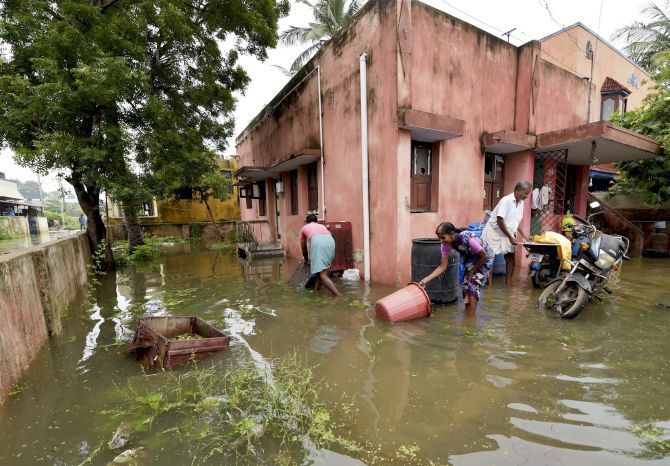'India, by virtue of its gigantic population and geography, stands at the very front line of this climate catastrophe.'
'But this is a threat that our easily distracted national mind is ill-equipped to think about, let alone plan for,' says Rahul Jacob.

Last month a teenaged girl in Bengaluru stepped out as floodwaters rose in parts of the city to relieve herself and was washed away in a storm drain.
Floods across India -- from Assam to Bihar to Mumbai, Bengaluru and Chennai -- have been as recurrent as railway accidents in 2017.
India's 70th Independence anniversary in one of Bengaluru's wealthiest neighbourhoods was, tellingly, the occasion of a massive sewage overflow brought on by poor civic planning and an overnight downpour.
Against this backdrop of recurrent water-logging in India's cities and the countryside this year, reading the International Monetary Fund's recent report on the effects of possibly accelerating global warming in developing countries is alarming.
The report suggests that global temperatures could rise by four degrees Celsius by 2100 without further action to tackle climate change.
'Extreme weather events such as heat waves, droughts, and floods are likely to become more frequent,' the report says.
The IMF estimates that a 1°C increase in temperature in a country with an average annual temperature of 25°C would reduce per capita output by up to 1.5 per cent, a loss that persists for at least seven years.
If no changes in emissions are made, less developed warm countries will lose a tenth of their potential output by 2100 -- and a lot of lives.
After a year like 2017, with the destruction wrought by weather gods dominating the news from Houston to Hong Kong, one would have to be living in a world of one's own to deny the effects of climate change.
And, yet much of the governing elite and middle class in India appear oblivious.
Until subsidies for diesel were withdrawn a couple of years ago, ever larger diesel SUVs in Delhi, in particular, commandeered the roads taking advantage.
Every flood in Mumbai is an occasion for saluting the 'Mumbai spirit', though this year, at last, there was fatigue with the tired phrase.
Our enormous cities, some the size of small countries, are still (mis)managed by mayors whose names we can't remember and who have no political power.
Our state electricity boards need periodic infusions of cash so they can continue to subsidise power that leads to over-irrigation in rural areas and depletion of our groundwater levels.
India, by virtue of its gigantic population and geography, along with parts of Africa, stands at the very front line of this catastrophe.
But this is a glacially incremental threat that our easily distracted national mind is ill-equipped to think about, let alone plan for.
The villains are in many cases ourselves so there are no easy targets for our TV channels. Our government revels in simple sloganeering and short timelines.
By contrast, climate change is a profoundly complex, diffuse problem for which rich countries are partly responsible.
The Mughals or the Nehrus can't be blamed and the problem probably can't be fixed by 2019 or 2022.
In fact, a 400-page report a decade ago by the Food and Agriculture Organisation said the culprits were sheep, chickens and cows who account for more greenhouse emissions than cars and other forms of transport.
Then there is the problem of our lack of civic spirit, manifest in our inability to plan cities and observe zoning regulations or conserve water in the countryside with rainwater harvesting and drip-feed irrigation.
Bengaluru, because it has grown so fast, is exhibit A.
A recent Indian Institute of Science study found that the city's flooding was the result of massive, unplanned concretisation of the city, with little regard to preserving wetlands and lakes.
The number of lakes in Bengaluru had reduced from nearly 285 in the early 1970s when I began visiting my grandparents there in the so-called pensioner's paradise of 161 square km to 194 lakes in 2006 in a city that had cannibalised the countryside and become a behemoth of 741 square km.
As with other Indian cities, construction debris piles up outside homes that cost crores and is usually left to be removed by the wind or rainwater, which means drainage is clogged with debris.
My brother has fought a lonely battle within his massive building complex for rainwater harvesting, but even with an oscillating crisis between water shortages and floods, there are few takers.
Bellandur lake in south-east Bengaluru is so clogged with industrial pollutants that you can find clips on YouTube of it spontaneously frothing and even bursting into flames.
The unyielding march of climate change and pollution continues, meanwhile.
Sixteen of the 17 warmest years registered in modern times have occurred since the beginning of the 21st century.
Punjab, the cradle of the Green Revolution, is now in the midst of an agricultural crisis.
Even for the non-religious among us, watching the ghastly sight of a lake catching fire seems like a curse from the gods.
But the moment soon passes and we turn our attention instead to telling the contractor to expand that ugly water feature in the building complex and dump the leftover cement and mud outside for the municipality to clear up.
Rainwater harvesting can wait another year.











